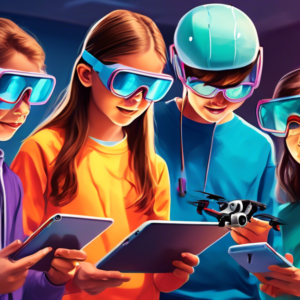Benefits of Interactive Drone Coding for Students
Interactive drone coding offers a unique and engaging approach to STEM education, fostering a range of skills in students grades 4-8. Here are some key benefits:
1. Enhanced Problem-Solving Skills
Drone coding challenges students to think critically and creatively to solve problems. They must plan flight paths, consider obstacles, and develop algorithms to control the drone’s movements. This process nurtures logical thinking and computational skills.
2. Development of Computational Thinking
Coding drones involves breaking down complex tasks into smaller, manageable steps. Students learn to analyze problems, identify patterns, and design algorithms, which are fundamental principles of computational thinking. These skills are essential for success in various STEM fields and beyond.
3. Hands-on STEM Learning
Interactive drone coding provides a hands-on learning experience that goes beyond theoretical concepts. Students can see the immediate results of their code as the drone responds to their instructions. This tangible feedback reinforces understanding and motivates further exploration.
4. Improved Spatial Reasoning
Controlling drones requires students to visualize and manipulate objects in three-dimensional space. They need to consider the drone’s orientation, altitude, and direction to navigate it successfully. This process enhances spatial reasoning skills, which are crucial for fields such as engineering, architecture, and design.
5. Teamwork and Collaboration
Drone coding activities often involve teamwork and collaboration. Students can work together to design flight plans, troubleshoot problems, and achieve common goals. This fosters communication, cooperation, and leadership skills.
Getting Started with Interactive Drone Coding
There are various ways to introduce interactive drone coding to students in grades 4-8. Here are some options:
1. Educational Drone Kits
Several companies offer educational drone kits designed specifically for STEM learning. These kits typically include a programmable drone, software, and curriculum materials. Some popular options include:
- Tello EDU
- Parrot Mambo Fly
- CoDrone EDU
2. Coding Platforms and Software
Various coding platforms and software can be used to program drones. These platforms often provide a visual block-based coding interface, making it easy for beginners to get started. Some popular choices include:
- Scratch
- Tynker
- Blockly
3. Online Resources and Tutorials
Numerous online resources and tutorials are available to support drone coding education. Websites, videos, and online communities provide guidance, project ideas, and troubleshooting tips.
Activities and Projects for Interactive Drone Coding
Here are some engaging activities and projects to inspire students in grades 4-8:
1. Obstacle Course Challenge
Set up an obstacle course with various challenges, such as hoops, tunnels, and landing pads. Students must code the drone to navigate the course autonomously.
2. Aerial Photography and Videography
Students can use drones equipped with cameras to capture aerial photos and videos. This activity can be integrated with geography, environmental science, or storytelling projects.
3. Search and Rescue Missions
Simulate search and rescue scenarios where students must program the drone to locate a target or deliver supplies to a designated area.
4. Drone Choreography
Combine coding with creativity by programming drones to perform synchronized movements or light shows.
